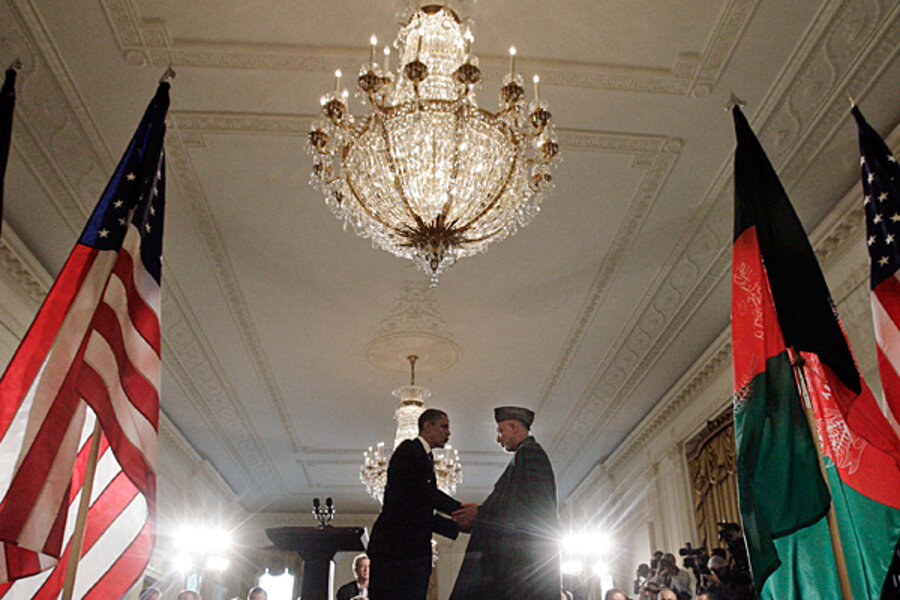Obama-Karzai talks near: How many US troops should stay in Afghanistan?
Loading...
| WASHINGTON
With Afghan President Hamid Karzai set to arrive for a meeting at the White House next week, the Obama administration is considering three options for how many troops it wants to leave in the country after NATO ends its mission in 2014.
President Obama and Mr. Karzai could make significant headway toward that decision as well as others, such as the pace of the US drawdown between now and 2014 and the sort of military hardware Afghanistan would like from the US. But approval of any Status of Forces Agreement, or SOFA, to keep US troops in the country remains contingent upon Karzai granting US forces immunity from local prosecution.
It was largely the question of immunity that derailed Mr. Obama’s plan to keep 3,000 US troops in Iraq beyond the December 2011 withdrawal date.
The size of a residual force for Afghanistan is likely to be larger – and potentially considerably larger – than the 3,000-strong force Obama envisioned for Iraq.
This week, the American commander in Afghanistan, Gen. John Allen, sent Defense Secretary Leon Panetta three scenarios calling for between 6,000 and 20,000 US troops to remain in Afghanistan. A contingent at the lower end of the range would focus primarily on counterterrorism activity carried out by Special Forces, while a force at the top of the range would allow for continued training of Afghan security forces and some joint operations with the Afghan military.
Obama has made no decisions on the size of a residual force, but in the past White House officials have suggested the president might opt for a force of about 10,000 troops.
This week, Pentagon officials said the US is likely to decide the size of any post-2014 force before turning to the question of the pace – or what Defense officials call the “slope” – of the drawdown of the 66,000 US forces in Afghanistan.
Some regional security experts say the best outcome of the meeting next week would be for Obama and Karzai to announce progress toward the conclusion of a SOFA – and perhaps even the number of US troops envisioned for a post-2014 force.
But Karzai has sounded resistant at times to the US insistence on immunity. Meanwhile, US officials and some members of Congress say that not one soldier will remain if immunity is not granted.
Last month, Karzai suggested after meetings in Kabul with Secretary Panetta that the immunity demand might depend on first sorting out who maintains control over detained Afghan citizens – particularly when it concerns key terrorist suspects. These are issues that “directly touch on Afghan sovereignty,” Karzai said.
Concluding a SOFA within the next few months would send an important message to key players in the Afghan conflict, says Dov Zakheim, a former undersecretary of Defense during the George W. Bush administration. The announcement of a SOFA would tell the Taliban that, while the US might be withdrawing the bulk of its forces, it is going to remain a force in the country and is not “turning its back on the country, as it did in the 1990s,” he wrote in the recent issue of The National Interest.
That would also be a valuable message to send to Afghanistan's neighbors – including Pakistan, which is seen to be harboring key figures in the Afghan Taliban as a means of maintaining influence in a post-US Afghanistan.
But other experts say that a SOFA with Afghanistan will only be helpful if the US force remaining in Afghanistan post-2014 is relatively large. If the US is to continue counterterrorism operations in South Asia – and particularly in Pakistan – its force in Afghanistan should number closer to 30,000 than the 20,000 at the top of General Allen’s range of force options, say Fred and Kimberley Kagan of the American Enterprise Institute.








